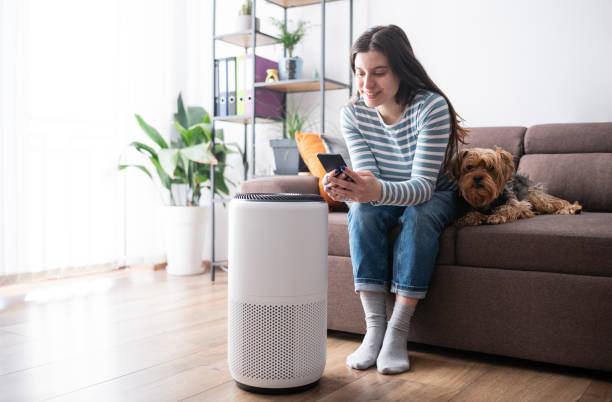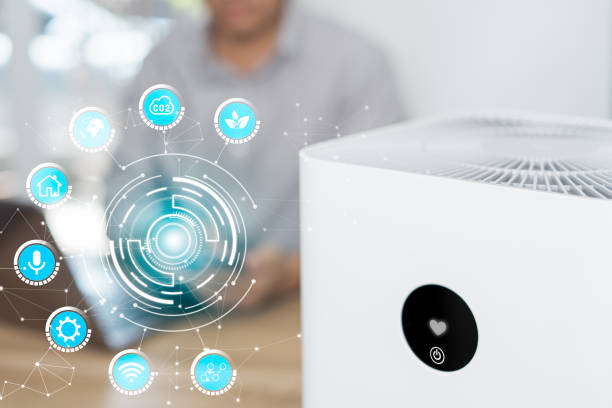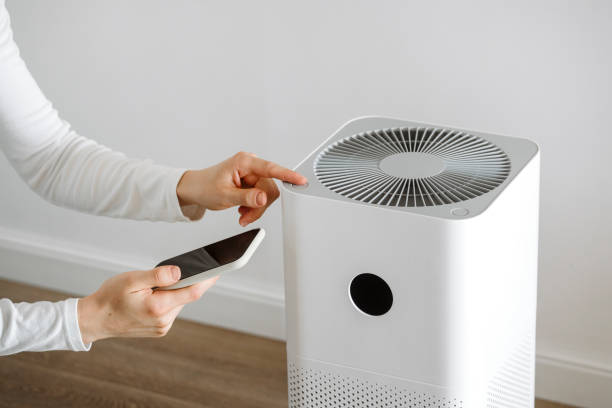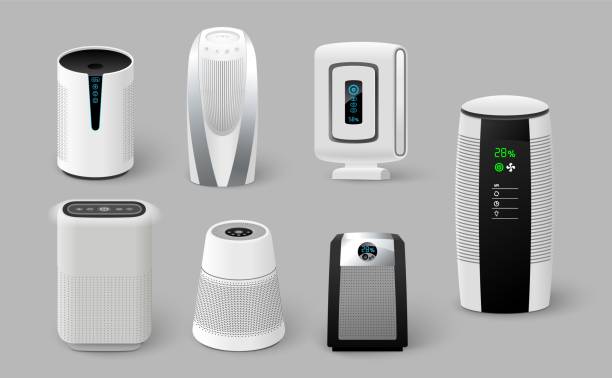
For millions worldwide, the changing seasons or even daily indoor life can trigger a cascade of uncomfortable allergy symptoms – sneezing, itching, congestion, and watery eyes. In 2025, with increasing awareness of indoor air quality (IAQ) and advancements in smart home technology, achieving significant allergy relief within your own living space is more attainable than ever. This guide delves into the top-rated smart air purifiers and innovative ventilation devices designed to transform your home into an allergy-proof sanctuary.
Why Smart Air Purifiers and Ventilation Matter for Allergy Relief

Our homes, while offering shelter, can inadvertently become reservoirs for allergens. Common culprits include dust mites and their excrement, pollen carried in from outdoors, pet dander, mold, mildew, and fungal spores . Beyond these, concerns like wildfire smoke, volatile organic compounds (VOCs), and airborne pathogens (including viruses and bacteria) further degrade indoor air quality, exacerbating respiratory issues and allergy symptoms .
Poor indoor air quality not only triggers immediate allergic reactions but can also lead to chronic respiratory problems and a general decline in well-being. This is where high-efficiency air purifiers and intelligent ventilation systems step in. Air purifiers with true HEPA filters are specifically designed to capture fine particles, effectively removing up to 99% of common airborne allergens . Complementing this, smart ventilation systems ensure a continuous supply of fresh, filtered air while expelling stale, allergen-laden indoor air, creating a healthier, less reactive environment .
Key Features to Look for in Allergy-Relief Devices

Choosing the right device can be overwhelming given the array of options. Prioritizing certain features will ensure you invest in effective allergy relief:
- True HEPA Filtration: This is non-negotiable for allergy sufferers. True HEPA filters capture at least 99.97% of airborne particles as small as 0.3 microns, including pollen, dust mites, pet dander, and mold spores . Many top models also incorporate activated carbon filters to tackle odors and VOCs .
- Smart Sensors and Automatic Modes: Modern smart purifiers and ventilation systems feature built-in sensors that monitor indoor air quality in real-time, detecting pollutants, CO2, and humidity levels . They can then automatically adjust fan speed to maintain optimal air quality, providing effortless purification without constant manual intervention .
- Connectivity and Control: Wi-Fi connectivity and intuitive smartphone apps allow you to monitor air quality data, control settings, set schedules, and even order replacement filters remotely . Voice assistant compatibility further enhances convenience. This is particularly beneficial for those with mobility issues or busy schedules .
- Coverage Area (CADR): The Clean Air Delivery Rate (CADR) indicates how quickly an air purifier cleans a room of a specific size. Match the CADR to your room dimensions for effective purification. Many products also specify a recommended room size .
- Noise Levels: For devices running continuously, especially in bedrooms, low noise levels are crucial. Look for models with quiet operation, particularly on lower settings .
- Energy Efficiency: As these devices run for extended periods, energy-efficient models can save on electricity bills.
- Certifications: Look for certifications like the Asthma & Allergy Friendly® mark, which indicates products scientifically proven to reduce exposure to allergens and irritants.
Top-Rated Smart Air Purifiers for Allergy Relief in 2025

Our extensive research and analysis of expert reviews, including those from Wirecutter, Live Science, and Tom’s Guide, reveal several standout smart air purifiers for allergy sufferers:
- Coway Airmega AP-1512HH Mighty: Consistently a top performer, the Coway Mighty has been a Wirecutter favorite for years due to its exceptional and consistent performance . It averages over 99% smoke removal in 30 minutes on its high setting, and impressively, its performance doesn’t significantly drop even after a year or two of continuous use . While not strictly requiring smart controls for efficacy, its optional smart features add significant utility, allowing for app control and scheduling . It’s excellent at capturing common allergens like dust, pollen, mold spores, pet dander, and even viruses .
- Levoit Core 600S: This model earns high praise for its robust air-cleaning performance, user-friendly smart features, and overall ease of use . It’s effective against a broad range of allergens and offers a strong CADR for its size, making it a powerful tool for maintaining clean air. The Levoit Core 400S is also a highly-rated option from the same brand, specifically highlighted as “Best Overall for Allergies” in some reviews .
- Rabbit Air MinusA2 SPA-780N / A3: Known for its quiet operation, multi-stage filtration system (including pre-filter, medium filter, True HEPA, activated carbon, and customizable options), and sleek design, the Rabbit Air models offer excellent air-cleaning performance . The customization feature allows users to tailor filtration to specific concerns, such as pet allergies or odors.
- Mila Air Purifier: A favorite for allergy sufferers according to Tom’s Guide, the Mila stands out with its seven interchangeable filters, allowing users to choose specific filters for their needs (e.g., “The Rookie Parent” for families or “The Basic Breather” for daily use) . Its modern design, easy setup, comprehensive app control, and a unique room presence sensor (adjusting noise levels when occupied) make it a smart choice for families and anyone prioritizing both aesthetics and performance . While it can be noisy on high settings when air quality is poor, it’s highly effective .
- Blueair Blue Pure 211+ Auto: This model is recognized for its high Clean Air Delivery Rate (CADR), making it a great option for larger rooms and effective against dust, pollen, and smoke . Its simple one-button operation and real-time air quality display offer straightforward functionality. While it might lack some advanced smart app features of other models, its core performance for allergy relief in larger spaces is commendable .
Popular and highly recommended products
1. S&P NASHIRA Smart Ventilation System
- A dual-flow Controlled Mechanical Ventilation (CMV) unit that extracts stale air and brings in fresh, filtered air.
- Equipped with AIRSENS indoor air quality sensors that detect pollutants in real-time and adjust ventilation automatically.
- Features heat and cooling recovery to maintain indoor temperature efficiently, reducing energy costs.
- Integrates with S&P’s Connectair® IoT platform for remote control and personalized air quality management.
2. Astberg Heat Recovery Ventilators (HRVs) and Energy Recovery Ventilators (ERVs)
- Balanced ventilation systems that improve indoor air quality by exchanging stale indoor air with fresh outdoor air while recovering heat or energy.
- Suitable for homes in areas with low outdoor pollution and regular breezes.
- Can be combined with smart sensors and air purifiers for enhanced allergen control.
- Known for energy efficiency and moisture control, helping prevent mold growth.
3. Levoit Core 600S Air Purifier
- Highly rated for allergy relief with HEPA and activated carbon filters that capture dust, pollen, pet dander, and VOCs.
- Smart features include app control, air quality sensors, and compatibility with voice assistants.
- High Clean Air Delivery Rate (CADR) suitable for medium to large rooms.
4. uHoo 9-in-1 Smart Air Quality Monitor
- Provides comprehensive monitoring of allergens and pollutants including PM2.5, VOCs, CO2, temperature, humidity, radon, and more.
- Integrates with smart home systems and offers real-time alerts and data visualization via app.
- Helps optimize smart ventilation by identifying specific indoor air quality issues.
5. Smart Exhaust Fans with Humidity and VOC Sensors
- Automatically activate based on indoor air quality changes, especially in kitchens and bathrooms.
- Help reduce moisture and VOC buildup, preventing mold and allergen proliferation.
- Some models learn user routines for optimized energy-efficient operation.
6. Robotic Vacuum Cleaners with HEPA Filtration
- Devices like those recommended by Allergy Standards Ltd. effectively reduce dust, pet dander, and pollen on floors and carpets.
- HEPA filters capture 99.97% of particles as small as 0.3 microns, preventing allergens from recirculating during cleaning.
Smart Ventilation Systems: The Unsung Heroes of Allergy Control
While air purifiers clean the air already inside your home, smart ventilation systems actively bring in fresh, filtered air while expelling stale, allergen-laden indoor air. This comprehensive approach is vital, especially in modern, airtight homes .
One of the most significant trends in home ventilation for 2025 is the rise of smart ventilation systems that use advanced sensors to monitor indoor air quality factors like CO2 levels, humidity, and fine particulate matter . These systems then automatically adjust ventilation rates, ensuring optimal air exchange without wasting energy .
Dual-flow Mechanical Ventilation (VMC Double Flow), also known as Heat Recovery Ventilation (HRV) or Energy Recovery Ventilation (ERV) systems, are particularly beneficial. These systems provide continuous air renewal while recovering heat from the outgoing air to preheat the incoming fresh air . This process ensures you get a steady supply of filtered outdoor air without significant energy loss, especially crucial in climates with extreme temperatures. For allergy sufferers, the benefits are immense:
- Reduction of Allergens: High-quality ventilation systems effectively filter out outdoor allergens like pollen and reduce indoor allergens such as dust, pet dander, and mold spores by constantly circulating and replacing indoor air .
- Humidity Control: Proper ventilation prevents excessive humidity, a common cause of mold and mildew growth, which are significant allergy triggers .
- Elimination of Odors: Beyond allergens, these systems also help remove cooking odors, pet smells, and VOCs, contributing to overall indoor freshness .
- Improved Respiratory Health: By maintaining lower concentrations of pollutants and allergens, ventilation systems reduce the risk of respiratory illnesses and improve general air quality for easier breathing .
Integrating smart ventilation with smart air purifiers creates a powerful defense against indoor allergens, addressing both the removal of existing pollutants and the prevention of new ones from accumulating.
Real-Life Case Studies and User Experiences
The impact of these smart devices on allergy sufferers is often profound. One reviewer from Tom’s Guide, a lifelong allergy sufferer, found that simply using an air purifier for an hour before sleep significantly improved morning sniffles and sneezing fits within days, leading to the ability to breathe easily within a week . This personal testimony underscores the immediate and tangible relief these devices can provide.
Similarly, the consistent performance of devices like the Coway Airmega Mighty, which maintains its 99% purification efficiency even after prolonged use, offers peace of mind to users looking for reliable, long-term allergy solutions . Users with mobility or dexterity issues have also highlighted the meaningful utility of smart control capabilities, allowing them to manage their air quality effortlessly via apps or voice commands .
Beyond individual anecdotes, certified products like the CleanForce Rainbow Series, recognized by Allergy Standards Limited, demonstrate a commitment to proven allergy relief. These real-world examples and certifications build trust, affirming that investing in these technologies can lead to genuinely healthier and more comfortable living environments, potentially reducing reliance on allergy medications and improving overall sleep quality.
How to Choose the Right Smart Air Purifier and Ventilation Device for Your Home
Making the best choice requires considering your specific needs and home environment:
- Assess Room Size and Allergen Types: A small, compact purifier might suffice for a bedroom, but larger open-plan areas will require a higher CADR . Consider your primary allergens – whether it’s pet dander, pollen, or general dust – to prioritize specific filter types.
- Budget Considerations: Beyond the initial purchase price, factor in the cost and frequency of filter replacements . Some premium models might have higher upfront costs but lower long-term maintenance.
- Certifications and Verified Claims: Prioritize devices with certifications from reputable organizations like the Asthma & Allergy Foundation of America (AAFA) or Allergy Standards Limited, as these signify rigorous testing for allergen removal .
- Smart Home Integration: If you have an existing smart home ecosystem, check for compatibility to ensure seamless control and automation alongside other smart devices.
Frequently Asked Questions (FAQs)
Q: What is the best air purifier for allergies in 2025?
A: Top contenders for allergy relief in 2025 include the Coway Airmega AP-1512HH Mighty, Levoit Core 600S, Rabbit Air MinusA2, and Mila Air Purifier, each excelling in different aspects from consistent performance to smart features and customizable filtration .
Q: How do smart air purifiers differ from regular air purifiers?
A: Smart air purifiers go beyond basic filtration by incorporating features like Wi-Fi connectivity, app control, voice assistant compatibility, smart sensors for real-time air quality monitoring, and automatic adjustment of fan speeds based on detected pollutants. They often provide data on indoor air quality trends and allow for scheduling .
Q: Can air purifiers completely eliminate allergy symptoms?
A: While air purifiers significantly reduce airborne allergens and can provide substantial relief, they typically do not completely eliminate allergy symptoms. They are most effective as part of a comprehensive allergy management strategy that might also include regular cleaning, allergen-proof bedding, and medical consultation.
Q: How often should I replace air purifier filters?
A: HEPA filters typically need to be replaced annually, while activated carbon filters might need replacement every 6-12 months, depending on usage and air quality conditions . Pre-filters are often washable and should be cleaned regularly according to the manufacturer’s instructions.
Q: Are ventilation systems necessary if I have an air purifier?
A: Air purifiers and ventilation systems serve complementary but distinct functions. Air purifiers clean the air within a room, recirculating and filtering existing air. Ventilation systems, especially smart ones, bring in fresh, filtered outdoor air and expel stale indoor air, controlling humidity and preventing allergen buildup that purifiers alone might not address . For comprehensive allergy management and optimal indoor air quality, both are highly recommended.
Q: Do smart air purifiers consume a lot of electricity?
A: Many modern smart air purifiers are designed with energy efficiency in mind. While power consumption varies by model and fan speed, many operate on relatively low wattage, especially on lower, continuous settings. Look for ENERGY STAR certified models for guaranteed efficiency.
Q: Can these devices help with pet allergies?
A: Yes, air purifiers equipped with true HEPA filters are highly effective at capturing pet dander, a common allergen. Models with activated carbon filters can also help neutralize pet odors .
Conclusion
Investing in top-rated smart air purifiers and responsive ventilation systems is a proactive step towards transforming your home into a haven for allergy sufferers. By understanding the critical role these devices play in maintaining pristine indoor air quality, you can make informed decisions that lead to significant allergy relief and a healthier, more comfortable living environment. Explore the features, compare the top models, and take control of your indoor air to breathe easier and live better. Visit SmartHomesBee.com for more detailed product reviews and buying guides.